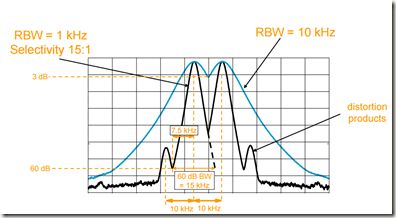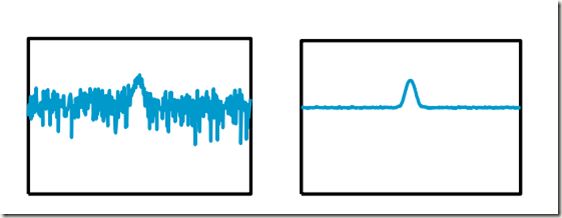扫频式频谱分析仪的结构如下图
RBW(Resolution Bandwidth)的影响
The RBW dictates the resolution bandwidth, which is related to the minimum bandwidth detectable by the instrument. The smaller the bandwidth, the more spectral resolution. However, there is a trade-off between how quickly the display can update the full frequency span under consideration and the frequency resolution, which is relevant for distinguishing frequency components that are close together. For a swept-tuned architecture, this relation for sweep time is useful:Where ST is sweep time in seconds, k is proportionality constant, Span is the frequency range under consideration in hertz, and RBW is the resolution bandwidth in Hertz.
It determines the RF noise floor and how close two signals can be and still be resolved by the analyzer into two separate peaks. Decreasing the bandwidth of an RBW filter decreases the measured noise floor and vice versa. This is due to higher RBW filters passing more frequency components through to the envelope detector than lower bandwidth RBW filters, therefore a higher RBW causes a higher measured noise floor.
VBW(Video Band Wdth)
Averaging or peak detection then refers to how the digital storage portion of the device records samples—it takes several samples per time step and stores only one sample, either the average of the samples or the highest one.The video bandwidth determines the capability to discriminate between two different power levels. This is because a narrower VBW will remove noise in the detector output.This filter is used to “smooth” the display by removing noise from the envelope. Similar to the RBW, the VBW affects the sweep time of the display if the VBW is less than the RBW. If VBW is less than RBW, this relation for sweep time is useful:
Displayed average noise level
The Displayed Average Noise Level (DANL) is just what it says it is—the average noise level displayed on the analyzer. This can either be with a specific resolution bandwidth (e.g. -120 dBm @1 kHz RBW), or normalized to 1 Hz (usually in dBm/Hz) e.g. -170 dBm(Hz).Spectrum analyzers usually characterize this by specifying the displayed average noise level (DANL) in dBm, with the smallest RBW setting. DANL is another term for the instrument’s noise floor given a particular bandwidth and represents its best-case sensitivity. It is impossible to measure input signals below this noise level. Generally, sensitivity ranges from –135 dBm to –165 dBm. To achieve optimum sensitivity, try using the narrowest RBW possible, sufficient averaging, a minimum RF-input attenuation, and/or a preamplifier, although increasing sensitivity may conflict with other measurement requirements, such as minimizing distortion or maximizing dynamic range.
现代频谱仪采用全数字中频结构,如下图
参考资料 1 Spectrum and Signal Analyzer Measurements of Agilet




